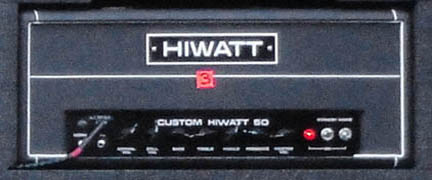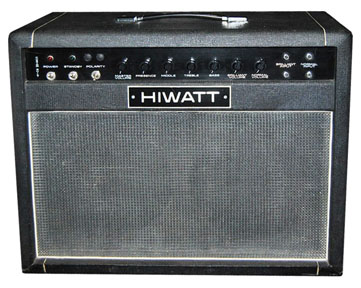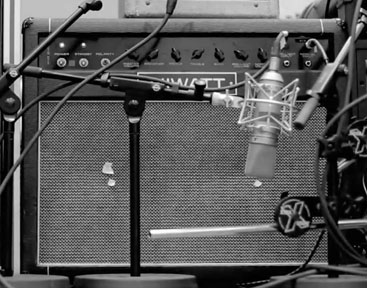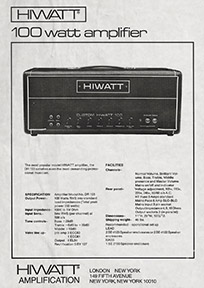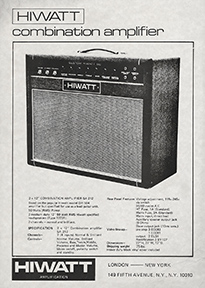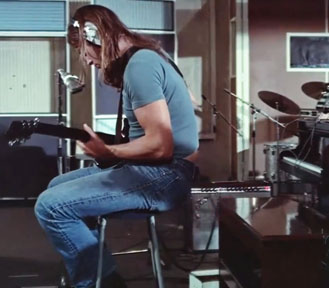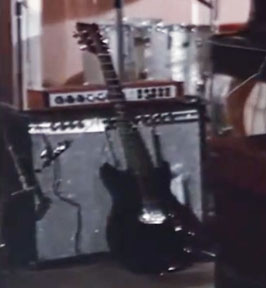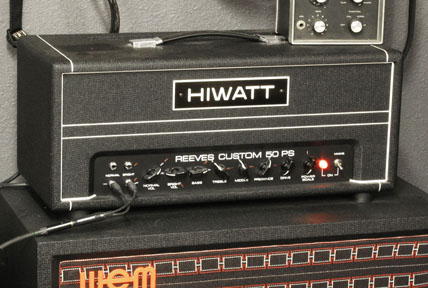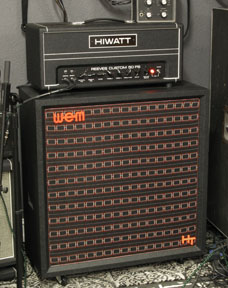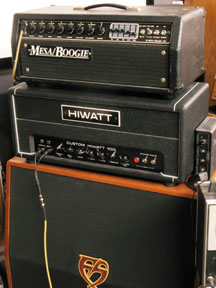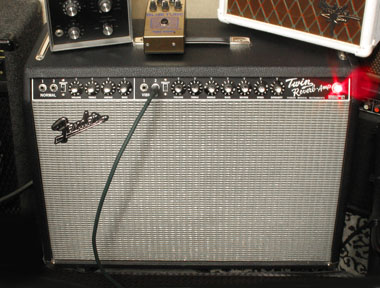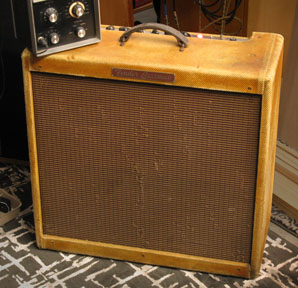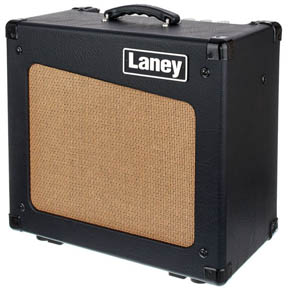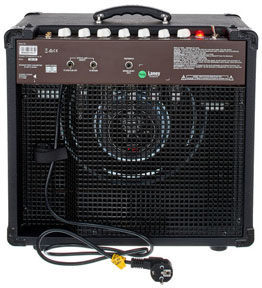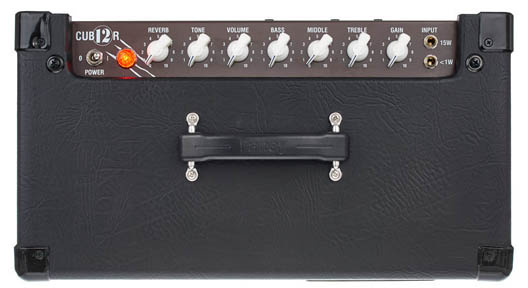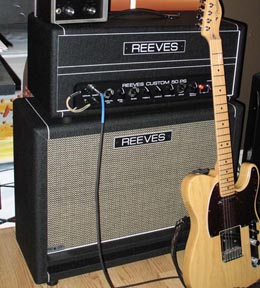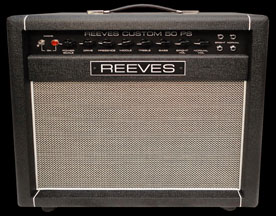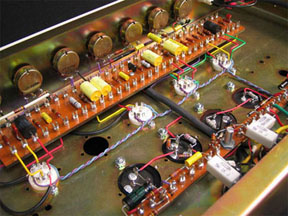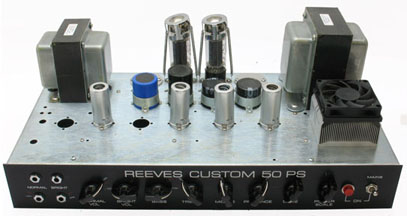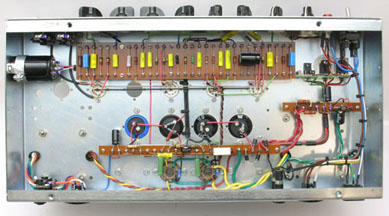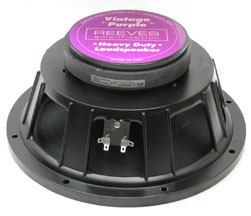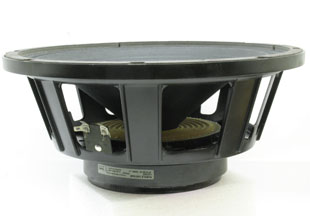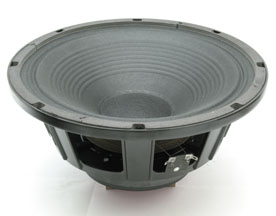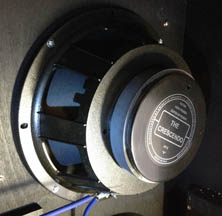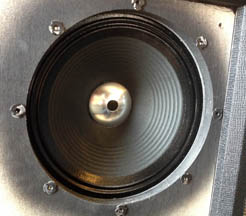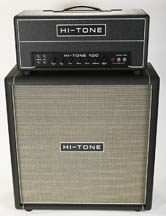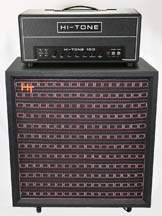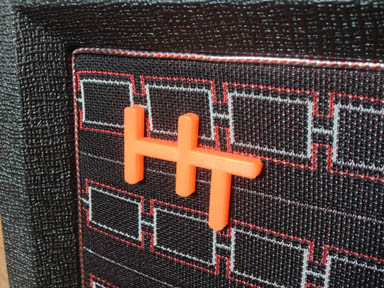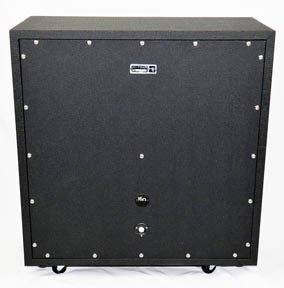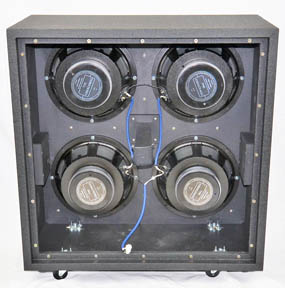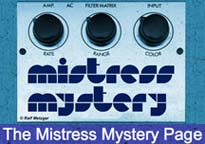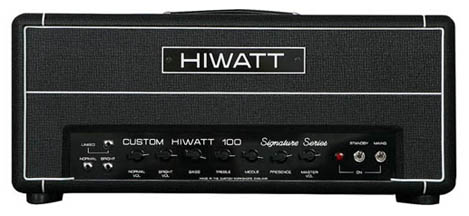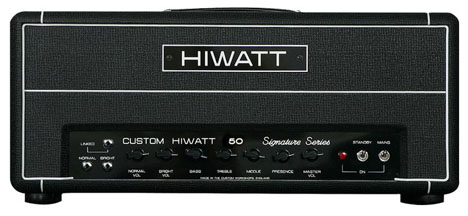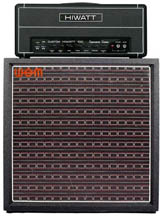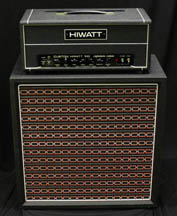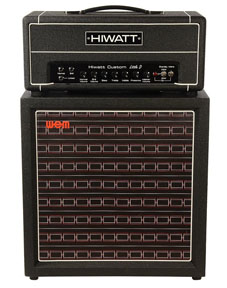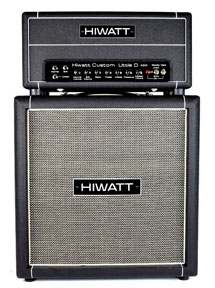NOTE: This website is frequently updated. Last update April 2022
"I've found that if you use a big amp, it only works in big rooms. And little amps only work in little rooms. I've got Fender amps, tiny little things, that sound enormous sometimes if you get them in the right place" - David from Guitar Player Magazine, 1984
TYPES OF AMPLIFIERS - For amplification, David Gilmour typically uses clean, real tube amplifiers with lots of headroom. "Clean" meaning the sound does not break up or distort very much, and "headroom" meaning it remains clean at high volume. This is important because most of Gilmour's distortion and overdrive tones come from pedals, not the amp. Most tube amplifier circuits distort more as volume is increased, which alters the pedal tone. David has used a variety of clean amps in the studio and performing live, but the most well known type he has used is the 100w Hiwatt DR103 model. It is also known as the Custom Hiwatt 100, from the name on the control plate, and the AP, or "All Purpose" model, from the AP type designation on the serial number plate. If any amp can be said to be a defining one for Gilmour tones, it is the Hiwatt. Below is a soundclip of various Gilmour clean and overdrive amp tones, beginning with David's early1970s Hiwatt tones.
Hiwatt Clean and Overdrive Tones - early 1970s Gilmour Hiwatt tones
A Hiwatt is what I recommend Gilmour afficionados start with, but there are many other options, such as Fender amps. David has used numerous Fenders on stage, such as the silverface Twin Reverb, '83 Concert Combo, '83 Twin Reverb II, a pair of 1990s 59 Bassmans, and a tweed Bandmaster. He has also used those in the recording studio, as well as a '72-74 Dual Showman Reverb, '56-58 Tweed Twin-Amp, 1982-86 Super Champ, '55 Bandmaster, '50s Tweed Deluxe, Tremolux, and a Champ. In a few instances (1990 and 1994) he has used an Alembic F2-B preamp in place of the preamp stage of his Hiwatt amps. The Alembic was basically a Fender Twin/Fender Showman preamp, so this was a way of combining the Fender preamp tone circuit and Hiwatt power amp tones. Another way was when he giggged and recorded throughout the 1990s with a stereo rig consisting of a pair of 59 Fender Bassman combo reissues and a pair of Hiwatt SA212 combos. He has also used a 1977 era Mesa/Boogie Mark I, '86 Gallien-Krueger 250ML, Seymour Duncan Conterible 100 combos, a late '50s Magnatone 260 2x12 combo, several small Alessandro amp heads, and a 1950s-60s Gibson GA-20T Ranger combo. Another amp type David has used both in the studio and on stage are rotary speaker cabinets and rotary amps like the Leslie 147, Maestro Rover, Leslie G27, and the Yamaha RA-100. Those were often blended with the sound of a regular amp/cab, so they were used like a modulation effect, in a similar manner as David has used modulation effect pedals like the Uni-vibe, Electric Mistress, and Boss chorus.
David uses pedals to create his overdrives and distortions and to color his clean tones, so it is important that the basic foundational amp tone be relatively clean as that is what everything else is filtered through. There are exceptions, but the clean channels in many classic Marshalls or Vox amps are not the best foundational amps for Gilmour tones. Solid state amps will work, as long as they are clean, but real tube amps sound better in my opinion. You may have heard of the famous Fender "bell" tone or the Hiwatt "chime". Those are the amp tones with sound frequencies that work best for a Gilmour rig. Pedals like the Big Muff, Fuzz Face, and Tube Driver seem to react with and sound much better with that style of amp. Sending a Big Muff or distortion pedal into a dirty and distorted amp generally sounds bad for Gilmour tones, but there are cases where David has done exactly that to create a blend of tones. For a great buyers guide to Gilmourish sounding amps, please visit Gilmourish.com.
David Gilmour's Custom Hiwatt 100/DR103 and Custom Hiwatt 50/DR504 amplifiers, both with linked input channel modifications
Hiwatt SA212 Custom 50 combo amplifier and Gilmour's SA212 with Fane Crescendo speakers from his Medina studio in 2014
Since 1969 the Hiwatt has been very much associated with Gilmour's live and studio tones up to Pink Floyd's The Final Cut album in 1983, and his later solo work and live concerts from 2006 onward. A vintage 1970s Hiwatt DR-103/Custom 100 would be the ultimate foundational amp for most Gilmour tones. Gilmour has also used the 50w DR504/Custom 50 and SA212 combo models. In the beginning of his Pink Floyd tenure he used a Sound City L100 before switching to Hiwatts. Sound City branded amplifiers and speaker cabinets were designed by Hiwatt founder Dave Reeves and built by his Hylight Electronics business for Ivor Arbiter's Sound City store. They were essentially the same amps Reeves was making under his Hiwatt brand, just re-branded. Hiwatt went out of business in the early 1980s and the name was sold. The brand was resurrected a few years later and reissue Hiwatt amps are still being made today by Hiwatt UK, but are very expensive. Many people claim the reissues do not sound as good as the original Hylight era Hiwatts, although many who have owned them say they sound great. I have never tried a reissue Hiwatt UK amp myself, so I have no opinion on the sound or quality, but David has never used a reissue Hiwatt amp. He has continued to use his original 1974 Hylight Hiwatts throughout his career, which is a testament to how well those amps were made.
1970s advertisements for the Hiwatt DR103 100 watt amplifier and SA212 50 watt combo amplifier
There are less expensive high quality options available, if you don't mind not having the "Hiwatt" name on the amp. The modern Reeves (no relationship with the Dave Reeves family) Custom 100 or Custom 50, or the Hi-Tone HT100DG or HT50DG are excellent replicas of the original Hiwatt amplifiers. The Hi-Tone amps are even available with linked inputs like Gilmour uses. For all intents and purposes, those are Hiwatt DR103 and DR504 amps, just without the brand name. One thing to note is that Hiwatts are LOUD. I mean scary loud. Louder than 4 input Marshalls. So loud that they make other amps run away crying, and when they want to come crawling back, they can find their way home by following the earth shaking and soul moving sound of a Hiwatt. It is pointless to get one if you are only going to play it at bedroom volume as you will not get the sound you expect. That would be like buying a high performance sports car and never taking it out of first gear. Unless you have the means and space to play at high volume, you may want to consider another option, or get a Reeves amp with power scaling built in. That said, a 100w or 50w Hiwatt circuit running wide open with maximum power tube saturation through a 4x12 cab is something everyone should experience at least once in their lifetime. You don't just hear it. You feel, experience, and are moved by it.
COMPARISON SOUND CLIPS - Below are comparison cips of different amps and speakers using a Strat with EMG SA pickups, an EHX Green Russian Big Muff, a 1973 Ram's Head Big Muff, and a BKB/Chandler Tube Driver. All speakers were recorded with Sure SM57 microphones. No EQ, just some delay from a Free The Tone Future Factory and a little plate reverb from a Free The Tone Ambi Space to give it some room sound.
HIWATT SOUND - The Hiwatt DR103 or DR504 sound is very different from Fender amps like the Twin Reverb or Showman. In fact, the top end sound of a Hiwatt is unlike any other amp I have ever heard. It is an excellent amp to use with pedals, especially the Big Muff and B.K. Butler Tube Driver, but most pedals sound good through this amp. The signature Hiwatt voice is characterized by a clean sound with chiming highs, full upper mid range frequencies, and tight lows. There is no screetchy treble or flabby bass in a Hiwatt, and it sounds grood at any volume, but best at high volume. The Hiwatt also has a presence control that brightens the tone in a similar manner to the presence control on the Fender Bassman. Compared to the Fender Showman/Twin Reverb, the Hiwatt EQ stage has a much wider range of mid/high/low frequencies, and a tighter bass response. The Hiwatt EQ is plate driven like FMV (Fender/Marshall/Vox) tone stacks but with some unique modifications. The treble and bass EQ responses are similar to the FMV, but rather than a 10k-25k mids pot, the Hiwatt has a 100k pot for a much broader mid range response. The mid control is also strictly mid range focused, unlike a typical FMV mid control that also affects the treble and bass response.
Hiwatt DR103 with Green Russian Big Muff - In Any Tongue solo
Hiwatt DR103 with Rams Head Big Muff - In Any Tongue solo
Hiwatt (Reeves Custom 50) with a BKB 911 Tube Driver - Louder Than Words solo - overdrive setting
Hiwatt (Reeves Custom 50) with a BKB 911 Tube Driver - Louder Than Words solo - light drive setting
The DR103 and DR504 both have the same tone stack and transformer sound, but due to the smaller power amp stage the DR504 has slightly less headroom, slightly less bass, and sounds slightly more compressed at high volume. One advantage of the DR504 is that it takes less volume to get the power amp tubes into saturation than it does with the DR103. The DR504 will also break up into overdrive at a lower volume than the DR103, but at the moderate volume used for Gilmour tones they sound practically the same. The circuits are also basically the same, except the DR504 runs on two EL34 power tubes and a 50w output transformer, where the DR103 runs on four EL34s and a 100w OT. Even though it has less power, the DR504 is still a VERY loud amp, nearly as loud as the DR103. Having used both, I prefer the DR504.
FENDER BASSMAN SOUND - The 59 Bassman is a classic of Fender clean tone. In general, the Bassman has a more flexible tone range than the Twin Reverb, and like the Hiwatt, it includes a normal channel and a bright channel. The normal channel has a very similar Fender clean tone as the Bandmaster and Twin Reverb/Showman. The Bassman also has a presence control like the Hiwatt. That boosts upper-mid and treble frequencies of the power amp, giving it more chime than the Twin Reverb, and allowing it to stand out in a band mix like the Hiwatt. The Bassman sound is also more compressed than a Hiwatt or Twin Reverb. It breaks up and gets dirty at high volume, unlike the Twin and Hiwatt. At moderate volume it is clean and perfect for most Gilmour tones, but it also sounds great at low volume. It takes pedals very well, especially the B.K. Butler Tube Driver, Big Muff, and ProCo Rat. The bright channel of the Bassman sounds very good with a Big Muff. If you like the sound of David's guitar on the Pink Floyd's Division Bell album, that is a mix of the 59 Bassman and Hiwatt SA212. A lot of David's 1990s recordings were done with the 59 Bassman.
Fender 59 Bassman with Green Russian Big Muff - In Any Tongue solo
Fender 59 Bassman with BKB 911 Tube Driver - Louder Than Words solo
Gilmour recording with his Fender silverface Twin Reverb for the Dark Side of the Moon recording sessions in early 1973 (from Pink Floyd: Live at Pompeii)
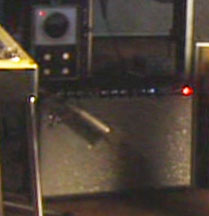
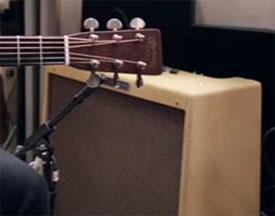
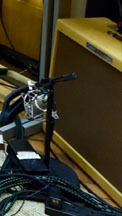
Gilmour's Fender silverface Twin Reverb (left) - like the one used in the Dark Side of the Moon recording sessions, and a tweed Fender combo (Bandmaster or Bassman)
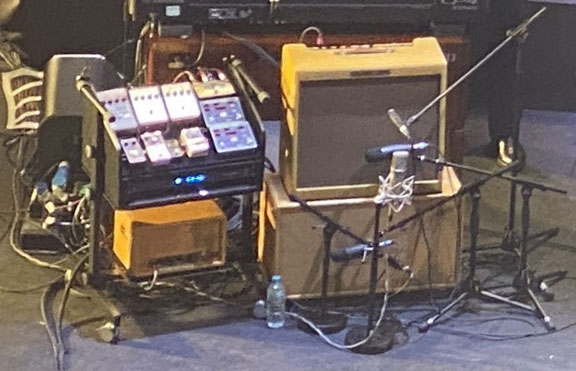
Gilmour's tweed Bandmaster (upper right combo amp) from the 2020 Peter Green Celebration. This may be a '55 Bandmaster, or the 57 Bandmaster reissue
FENDER TWIN REVERB/SHOWMAN SOUND - The Fender Twin Reverb and Showman are basically the same amplifier circuit. In fact, the Dual Showman Reverb that David used was essentially a Twin Reverb in head form. It gives a very warm, clear, and bassy classic Fender tube amp tone. It stays very clean at high volume and is one of the cleanest, loudest amps ever made. Think of the sound of the clean intro of Shine on You Crazy Diamond from the Wish You Were Here album. That was probably a guitar recorded direct into the recording console, not an amp, but that is very much what the clean tone of the Twin Reverb/Dual Showman sounds like.
The Twin Reverb tone is very similar to the 59 Bassman normal channel, but the Twin Reverb is slightly less flexible because it does not have a presence control. It does have a bright switch, which functionally is the same as the bright channel input on the Bassman. When switched, the sound is brighter at low volume and becomes less bright as the volume is increased. The bright switch sounds best when used with the treble dialed low, bass off, and mids set to 6 or less. Compared to the Hiwatt, the Twin EQ stage has a more limited range of mid/high/low frequencies, and has a looser bass response. Unlike the Hiwatt, a trademark of the Twin/Showman is its scooped mild mid range, but that deeply mid-scooped tone circuit is part of what makes the up the Fender tone, which is different than a Hiwatt.
It works very well with most pedals, but because of its scooped mid range, pedals with a flat or scooped mid range like the Big Muff Pi and B.K. Butler Tube Driver can sometimes get lost in a band mix. I usually dial the Big Muff tone knob more to the treble side with the Twin, much more than I do with any other amp. If you like the tones on Pink Floyd's Dark Side of the Moon, I believe much of that was recorded with a silverface Twin Reverb. David also used a Fender Dual Showman amp when recording Floyd's Wish You Were Here album, and much of David's 1984-1987 work was done with Twin Reverbs. Note that the Twin Reverb and the modern Fender Twin-Amp are two different amps. Both have a similar clean channel, tremolo, and reverb, but the Twin-Amp has a switchable high gain channel, and only 1 or 2 inputs.
Fender 65 Twin Reverb with Green Russian Big Muff - In Any Tongue solo
Fender 65 Twin Reverb with Colorsound Power Boost and Ram's Head Big Muff - Money solo (1977 Animals tour tone)
Fender 65 Twin Reverb with BKB 911 Tube Driver - Louder Than Words solo
Fender 65 Twin Reverb with Proco Rat - Louder Than Words solo
DIRTY FENDER AND HIWATT TONES - Below is a clip alternating between a Reeves Custom 50 (Hiwatt clone) with Vintage Purple (Fane style) speakers and a 65 Fender Twin Reverb with Jensen C12 speakers. Boss CS-2 compressor, 1973 Ram's Head Big Muff, Boss CE-2 Chorus, slight delay (480ms) from a TC Nova. Fender Strat with Seymour Duncan SSL-5 bridge pickup.
CLEAN FENDER AND HIWATT TONES - Here are just the clean amp tones. Strat with CS69 neck and middle pickups, and Seymour Duncan SSL-5 bridge pickup. Clips start with the neck pickup, then the bridge/middle position comes in at around 40 seconds. Blues melody at the end is the neck pickup.
VOLUME - Having the amp volume loud sounds best to me, but is not necessary with most amps. The hotter the tubes get in the amp, the more richly saturated and smooth the tone gets. The louder the speaker is, the more air the speaker will move and more of the full tonal frequency range will be heard. I also think having the volume right on the edge of feedback is best. In general, large amps/cabinets sound better in large rooms and halls, and small amps/cabinets sound better in small rooms. David has even said that he prefers recording with smaller amps in smaller rooms, and much of what is recorded on his floating studio, the Astoria, was done with smaller amps. That does not mean you cannot get a good sound out of a large amp in a small room - you can - it is just better to use an amp suited to the environment you will be playing in most of the time.
LOW VOLUME TONE VERSUS HIGH VOLUME - Playing at low, home/ apartment/ bedroom volumes with a large 50-100w combo or head/cab sounds OK, but you may not be getting the full tonal range out of the amp. Don't get caught up in the bigger is better mode. Get something that works best for your playing area and allowable volume. Smaller class A tube amps, 15w or less with one 10" or 12" speaker sound much better in small rooms. You can still get some tube saturation to make the tone sound its best. If volume is an issue, I definitely recommend going with a smaller, single speaker amps for the best tone. That said, my experience with the Hiwatt DR504, Reeves Custom 50, and Fender Bassman, is that they sound good at both very low and very high volume, even though they are all high powered tube amplifiers. I think moderate to high volume on these amps gives you a richer tone however.
Below are some audio clips comparing tube amps at both low and high volumes, to illustrate the difference in the tone. Other than volume, the amp settings are identical in each clip. The playing was recorded direct from the guitar into a Boss RC-3 looper and replayed through my pedalboard input, so each performance is identical
Low Volume with Reeves Custom 50 - very low "bedroom" volume, quiet enough to barely hear in the next room with a door closed
High Volume with Reeves Custom 50 - extremely high volume, right on the edge of feedback
As you can hear, there is very little difference with the 50w Hiwatt circuit. The difference is more noticeable in the 100w DR103 circuit, but not drastically. Below is the same test with a 59 Bassman and 65 Twin Reverb. The difference is much more noticeable on these classic Fender tube amps circuits.
Low Volume with 59 Bassman - very low "bedroom" volume, quiet enough to barely hear in the next room with a door closed
High Volume with 59 Bassman - extremely high volume, right on the edge of feedback
Low Volume with 65 Twin Reverb - very low "bedroom" volume, quiet enough to barely hear in the next room with a door closed
High Volume with 65 Twin Reverb - extremely high volume, right on the edge of feedback
The Twin Reverb sounds much more trebly and thin at low volume, and much fatter and fuller at high volume with full power tube tube saturation and a bit of speaker breakup. Of course, you can adjust the tone knobs to make it sound better than this at low volume, but it still won't sound exactly the same.
STEREO RIGS - TWO AMPS ARE BETTER THAN ONE - In most of David's large live rigs he ran two amplifiers at once, alwasy on, with a third as a spare. Usually each Hiwatt was sent to a pair of 4x12 speaker cabinets, one loaded with fane Crescendo speakers and the other loaded with Celestions speakers. This allowed him to have the blended sound of both speaker types, and to have one dedicated amp/cabs for the left channel and one for the right in his stereo rigs. He has also done a similar blended sound using two different types of combo amplifiers, such as Fender amplifiers blended with Hiwatt amplifiers, or Alessandro amplifiers blended with Hiwatt amps. In his smaller 1990s rigs he often used a pair of Hiwatt combo amplifiers and a pair of Fender Bassman combo amplifiers, for a stereo blend of both sounds.
BLENDING DIFFERENT TYPES OF AMPLIFIERS - David often blended two different types of amplifiers together to achieve a sound that combined the unique tonal characteristics of each amplifier, creating a fuller, richer sound. In the mid 1970s he blended his Hiwatt amp with a Fender Dual Showman head. For Pink Floyd's 1977 tour it appears David blended his Hiwatts with a Marshall Super Lead head, and possibly a Yamaha PA200 head. In the early 1990s he blended Fender Bassman combo amps with his Hiwatt SA-212 combo amps. Effects rig builder Pete Cornish described the resulting sound of this combination as "very full, as the Hi-Watts provided the solid low frequency foundation and the Fenders the smooth upper harmonics."
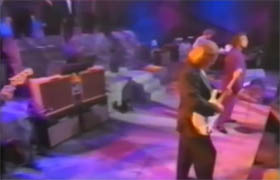
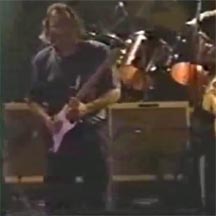
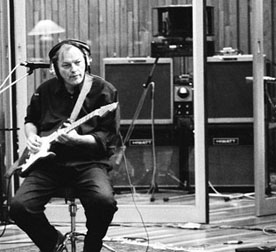
In 1987 David blended a Fender Super Champ and a Gallien Krueger 250ML. In 1990 he combined Seymour Duncan Convertible 100 amps with a Hiwatt SA-212 combo. In 1991 and 1994 David blended an Alembic F2-B preamp, which was essentially a Dual Showman preamp, with the power amp stage of his Hiwatts. At various times throughout the 2000s he blended Fender tweed combo amps with his Hiwatt combos. In 2006 he began blending his Hiwatts with Alessandro amps live, and continued that for his 2015-2016 tour. In 2010 and 2012 he was seen combining an Alessandro head and 2x12 speaker cab with a Hiwatt combo, and for the the 2020 Peter Green Celebration he combined an Alessandro amp head with a tweed Fender Bandmaster.
Below are a few sound clips of a 59 Bassman and Reeves Custom 50 individually, then a blend of the two to illustrate the fuller tone of both combined.
![]() Fender 59 Bassman only - Comfortably Numb Outro solo
Fender 59 Bassman only - Comfortably Numb Outro solo
![]() Reeves Custom 50 only - Comfortably Numb Outro solo
Reeves Custom 50 only - Comfortably Numb Outro solo
![]() Fender 59 Bassman blended with a Reeves Custom 50 - Comfortably Numb Outro solo
Fender 59 Bassman blended with a Reeves Custom 50 - Comfortably Numb Outro solo
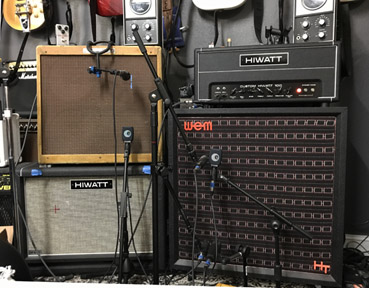
For many years I have been combining my Reeves Custom 50 or Hiwatt DR103 with my Fender 59 Bassman reissue, and sometimes with a Twin Reverb. When set up right, the result is the best of both worlds, but you have to be aware of possible phase issues. Some amps are out of phase with other amps which can cause phase cancellation of some frequencies, making the sound thin or hollow. For example, the normal channel of a Twin Reverb is out of phase with the Hiwatt, but the reverb channel is in phase. Using the reverb input on the Twin corrects that issue. When recording, you can also use reverse phase/reverse polarity adaptors on the mic's recording one of the amps to put both in phase, or flip the phase for one amp 180 degrees in your DAW.
Below are more examples of blending amps together with various amps and setups.
Fender 59 Bassman blended with a Reeves Custom 50 using a Green Russian Big Muff - On the Turning Away solo
Fender 59 Bassman blended with a Reeves Custom 50 using a Green Russian Big Muff - Sorrow solo
Fender 59 Bassman blended with a Reeves Custom 50 using a Tube Driver - Fat Old Sun solo
Fender 59 Bassman blended with a Reeves Custom 50 using a Ram's Head Big Muff - Mihalis solo
Fender 59 Bassman blended with a Reeves Custom 50 using a Green Russian Big Muff - In Any Tongue solo
Fender 59 Bassman blended with a Reeves Custom 50 using a Rams Head Big Muff - In Any Tongue solo
Fender 59 Bassman blended with an Alembic F2-B preamp into a Yamaha RA-200 rotary speaker cabinet - Green Russian Big Muff and Deluxe Electric Mistress - In Any Tongue solo
Fender 65 Twin Reverb blended with a Hiwatt DR103 using a Green Russian Big Muff - In Any Tongue solo
MY AMPLIFIERS AND MY RECOMMENDATIONS - I have a variety of amps, but my favorites and the ones recommend for Gilmour tones are a Reeves Custom 50 PS, a Fender 59 Bassman LTD, and a Fender 65 Twin Reverb. I use a few different speaker cabinets with the Reeves: a 2x12 cab loaded with Hi-Tone DR-F speakers, a 2x12 cab loaded with a Reeves Vintage Purple and Celestion G12T-75, a Hi-Tone Eclipse cab loaded with Crescendo A and Celestion G12T-75 speakers, and a custom made 4x12 ES cab (thanks Brett!) loaded with two Celestion G12T-75 speakers and two Fane Crescendo 12A speakers. If I had to pick only one amp and cab to take on a desert island to cover a wide varitey of tones, it would be the Reeves and Crescendo/Celestion cab. That is a very loud amp however, and may not be suited for low volume home, apartment, or bedroom playing. In that case I would take the 59 Bassman.
My Reeves Custom 50PS (with a Hiwatt badge) and a Hi-Tone Eclipse 4x12 cab loaded with Crescendo A speakers (customized with a WEM badge)and my Mesa Boogie
Mark III and Hiwatt Custom 100/DR103 with an ES custom 4x12 loaded with loaded with two Celestion G12T-75 speakers and two Fane Crescendo 12A speakers
My 65 Twin Reverb with Jensen C12 speakers and my 59 Bassman LTD with Eminence blue frame alnico speakers
MY AMPLIFIERS SETTINGS - The settings below should only be used as a starting point for your settings since the sound will vary depending on the type of speakers used and the size of your speaker cabinet. The same amp settings through a large 4x12 cab will not result in the same sound through a smaller 2x12 cab, even if you are using the exact same speakers. For example, my Hiwatt settings are based on using a 4x12 speaker cabinet with a closed back. If you are using a small 1x12 or 2x12 cab, you may have to dial down the highs and mids to get a similar sound. Smaller cabs also have a tighter and more focused sound than the larger cabs, especially with closed backs.
Here are a few things to keep in mind.
• The number of speakers affects the tone. Due to the mutual coupling of sound waves coming from each speaker cone, and reflecting through the back of each speaker cone, each additional speaker added to a cab cancels out some of the high frequencies and boosts the low mids and low frequencies.
• A large cab with a single speaker will have a fuller sound and more low end than a small cab with the exact same speaker, especially if it is a closed back cab. A large cab with a single speaker will sound more similar to a large cab with two or four speakers than a small cab with a single speaker.
• Closed-back cabinets sound more focused, have a fuller low end, and project the sound in one direction. Open back cabs spread the sound more in all directions and can sound looser, with less low end.
MY HIWATT / REEVES SETTINGS - I find the sound of the Hiwatt works well with practically any type of guitar pickup. Most settings sound good on this amp, but here are the settings I like on my Reeves Custom 50PS and Hiwatt Custom 100. I have two of the inputs linked to combine the Normal and Brilliant channels, but I tend to keep the Brill channel volume lower than the Normal. The PS in the Reeves is a built in Power Scaling citcuit designed by London Power to allow the saturated tube sound but at lower volumes. I use the Power Scaling about half the time when I play, usually set no lower than 12:00, which is still very loud, but much more woarble for people who can't run a Hiwatt wide open all the time. Setting it at 1:00 or higher retains the same sound it has at full power to my ears. Setting it low around 9:00 is safe for bedroom volume and sounds good, although it does lose some of richness in the tone frequencies that is has at higher power.
my Reeves Custom 50PS settings for a 1979-2015 Gilmour Hiwatt tone
my Hiwatt Custom 100 settings for a 1979-2015 Gilmour Hiwatt tone
my Reeves Custom 50PS settings for a mid 1970s Gilmour tone
my Hiwatt Custom 100 mid 1970s settings for a mid 1970s Gilmour tone
MY 59 BASSMAN SETTINGS - I find this amp sounds best with Stratocasters, Telecasters, and my Les paul with P90 pickups. Like the Twin reverb, the 50w 59 Bassman is also a two channel design with four inputs. There is a Bright channel with a high gain (1) and low gain input (2), and a Normal channel with high and low gain inputs. This is the same type of input configuration as the Marshall JCM series, as the very first Marshall amps were basically knockoffs of the Bassman. I found the Normal, high gain input seems to work best for Gilmour clean and light overdrive tones, but the Bright channel works much better with Big Muffs, or when combining with a Hiwatt. Each channel has its own volume control, but the volumes are interactive, as was the case with most tweed amps. If you are plugged into one channel, adjusting the volume of the unused channel affects the volume and tone of the other. In this application, it is best to keep the unused channel volume off. I keep the volume around 3-4. If you like the clean tones for things like the intro to Comning Back to Life, or the finger picked sound of EMG-SA or P-90 pickups for playing things like Cluster One or 5A.M., this is the amp for you.
This Bassman is VERY versatile. The tone range is so wide that you can play just about any type of music through it, but it takes some time to experiment and find the best settings. Like the Hiwatt, you can link the Bright and Normal inputs with a patch cord to combine the tone of each channel, but that's not necessary for Gilmour tones. The paper voice coil former in the blue frame alnico speakers in the older 59 Bassman reissues are more sensitive to high volume than the later Jensen speakers, so I rarely turn it up past 5. The Bassman will distort if you turn it up too loud, especially with humbucker pickups.
Here are 59 Bassman settings I use with Strats with EMG pickups, Telecasters, Tube Drivers, Rat, and Big Muffs.
I usually dial the Mids knob to maximum with Big Muffs
Here are alternate 59 Bassman settings I use with my Les Paul with P90 pickups and single coil Strats
MY 65 TWIN REVERB SETTINGS - I find this amp sounds best with Stratocasters and Telecasters. The Twin Reverb is a 100w amp and has two channels, a Normal channel and Vibratto/Reverb channel with a spring reverb tank and vibratto circuit. Each channel has a high gain input (1) and low gain input (2). Both channels and all four inputs can be used simultaneously. I typically use the low gain input of the reverb channel on my 65 Twin, or the high gain input on the normal channel. The circuitry on the reverb side sounds slightly warmer to me than the non-reverb side (there is an additional preamp tube on the reverb side) and the low gain input sounds slightly tamer with the pedals I use. I use the spring reverb to add a bit of smoothness to the tone, but sparingly. I never set it above 3 as it alters the sound in a negative way for most Gilmour tones. I also rarely use the bright switch for clean tones, as it can sound a bit too harsh. The bright switch can be used to good effect with distortion and overdrive pedal tones however, by dialing the bass off, the treble to 1 or 2, and the mids to 5 or 6. The Twin sounds best loud, and I run my volume at 4-5, but even with the volume as low as 3 it gives a good, rich clean tone. Below 3 and it loses a lot of the power tube saturation.
Here are my standard settings for the normal channel and reverb/vibratto channel of my Fender 65 Twin Reverb (ignore the speed/intensity tremolo settings on the right)
These work for clean tones, overdrives, and with Big Muffs
Here are some alternate settings I sometimes use on the reverb/vibratto channel
OTHER AMP RECOMMENDATIONS - For regular home use or small club playing at lower volume, smaller amps or single speaker combo amps are better suited. There are several good, low wattage amps and combos that work well with pedals to achieve most Gilmour tones. The Hi-Tone Lowatt 18w head or combo and the Trinity Amps Triwatt 22w and 33w heads were designed to get close to the Hiwatt DR series sound, but at much lower wattages using two 6V6 power tubes rather than four EL34 power tubes in the full sized Hiwatts. Combo amps like the Fender Super Champ, 22w Fender Deluxe Reverb, or 40w Fender Blues Deluxe also work very well. Smaller amps like the Laney CUB 12r, 15w Fender Blues Jr, 30w Peavey Classic 30, and 30w/5w Mesa 5:25 Express can also produce acceptable clean tones at low volume. For a more comprehensive guide to alternate Gilmourish sounding amps, check out the amp buyers guide on Gilmourish.com. Bjorn has some great suggestions on that website.
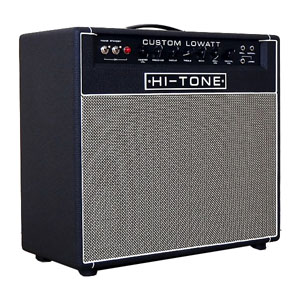
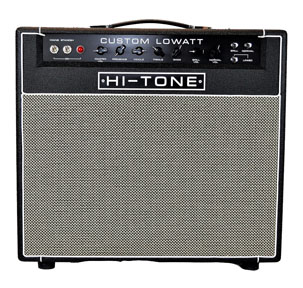
Hi-Tone Custom Lowatt 18w combo with 6V6 power tubes (left) and Trinity Amps Triwatt 22w head with 6V6 power tubes (right)
One of the best sounding budget amps that works great at home or bedroom volumes is the Laney CUB. It's a British sounding amp with a nice mid range, sort of a Hiwatt/Marshall tone mix. It has lots of headroom and sounds great with pedals, including Tube Drivers and Big Muffs. It goes into overdrive at high volume, but at moderate to low volume it stays clean and works very well for most Gilmour tones. It is available in a combo or head form with a separate 2x12 speaker cabinet. The Laney CUB 12R is a 15w class A/B combo amp with a 12" HH speaker, running three x ECC83 pre amp tubes and two x EL84 power amp tubes. It has a 15w input and a 1w power scaled input for very low volume playing. The Laney CUB Amp Head is the same, but in head form. It has slightly more headroom than the combo, so it's going to sound slightly better for Gilmour tones. The Laney CUB 2x12 Speaker Cabinet is meant to be paired with it, but you can use any 2x12 cab with 8 or 16 Ohm speakers. The CUB 2x12 is fitted with two HH speakers, and can be stacked horizontally or vertically under the CUB head.
Laney CUB 12R 15w combo amp with two EL34 power tubes and a 1x12 speaker
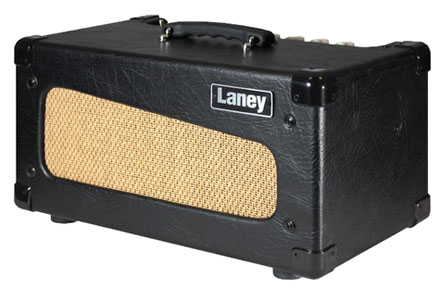
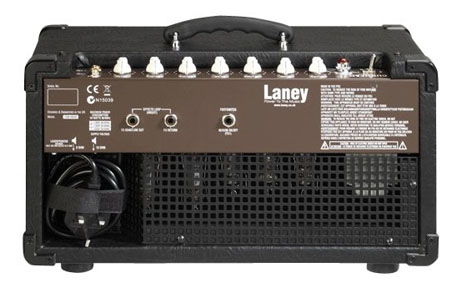
Laney CUB Amp Head - same as the 12R but in head form
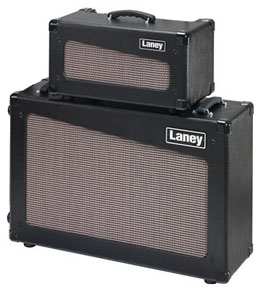
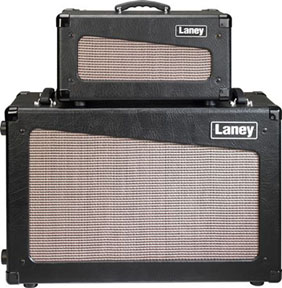
Laney CUB Amp Head and matching 2x12 speaker cabinet
WOT'S, UH THE DEAL WITH ALL THE DIFFERENT HIWATTS? - Just like the Fenders, it can be confusing to decide which Hiwatt to buy. David used original Hylight era Hiwatt Custom 100/DR103 (the DR stands for Dave Reeves, the owner/designer) and Custom 50/DR504 amp heads, with separate speaker cabinets. He also used the SA212 50w combo version with two 12" speakers. Vintage 1970s units can be found on the secondary market, although many need a cap replacement job or other servicing. The Hiwatt name has changed hands so many times that it is almost meaningless. All that matters is that the amp follows the correct component specs and build quality. There are several current production Hiwatt clones are very well made. Below is a brief rundown on the various Hiwatts and what was currently available at the time this was written. If you want more info on original Hiwatts, check out the Mark Huss Hiwatt Information Pages.
Original Dave Reeves/Harry Joyce era Hiwatts - Sound City, Hylight era Hiwatts or Biacrown era Hiwatts. No longer produced, and the men behind them, Dave Reeves and Harry Joyce, are sadly no longer with us. Dave Reeves designed and built his first original amp designs in 1964. In 1966 he founded Hylight Electronics and started selling his amps under the Hiwatt brand, while also building them for Ivor Arbiter's Sound City store, branded as Sound City amps, and for Macaris Musical Exchange, branded as Sola Sound amps. In 1967 he parted ways with Sound City due to disagreements over quality and began making Hiwatts full time in '68. By 1970 Dave needed help keeping up with orders so he contracted Harry Joyce Electronics to build the circuits. The amps from this era were made to high quality mil-spec standards, with turret board circuits, Partridge transformers, and are the most disreable. The Partridge output transformer was one of the most important aspects to the Hiwatt sound, providing a clean note definition, clarity in the high frequencies, and a solid low end.
Dave Reeves died in 1981. As he had divorced his wife, the company ownership went into litigation rather than to his surviving family. The ex Hylight employees got together, formed Biacrown Electronics, and purchased the Hiwatt name. Harry Joyce continued to make the amps for the new owners, but Biacorn only lasted a few years. Sales floundered in the 1980s, component quality cheapened, the company could not pay its bills, and eventually closed down in 1984. Rick and Justin Harrison, the father and son team that owned Music Ground in the UK, eventually purchased the remnants of Biacrown, including the Hiwatt brand name, and launched Hiwatt UK. Harry Joyce continued to make the Hiwatt amps branded under his own name until his death in 2002. Hylight era Hiwatts can be found on the used market, most easily through ebay or Reverb.
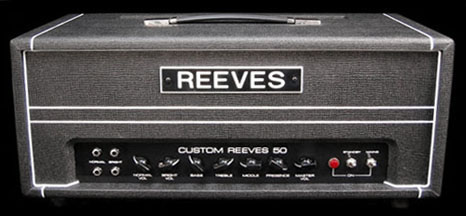
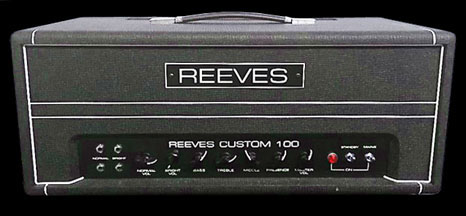
Reeves Custom 50 with two EL-34 power tubes and Reeves Custom 100 with four EL-34 power tubes
REEVES Amplification - Around 2003 Bill Jansen started out importing and selling rebadged Hiwatt UK amps (made in England) for the United States market out of his warehouse in Cincinatti, Ohio. Since Fernandes owned the Hiwatt trademark in the US, Bill had Hiwatt UK brand them with a REEVES badge instead, named after original Hiwatt designer/owner Dave Reeves. Dave Reeves actually branded some early Hiwatt production with REEVES badges himself in the 1970s just like these, although Reeves Amplification is not associated in any way with the Reeves family. In 2005 Bill decided to start producing the amps himself and sell direct after struggling to make his business and pricing work selling through dealers. Reeves Amplification produces vintage Hiwatt clones with EL34 power tubes that are very close to Dave Reeves original specs, along with a line of well made speaker cabinets.
Reeves claims the amps are made to the exact same specs as the originals, and better made products than the Hiwatt UK amps. They are built to order and entirely hand assembled in the USA using FR-5 turret board, Mallory or MOJO Dijon coupling caps, carbon composition and metal film resistors, and mil-spec style wiring like the originals. The Heyboer transformers Reeves uses are supposedly better than the original Partridge transformers, which were key to the Hiwatt sound. They were reverse engineered from real vinatge Partridge transformers supplied by Reeves. The power and output transformers have the same model numbers as the Heyboers that Hi-Tone uses, along with the same Partidge-style mounting brackets (some older production does not include the same mounting bracket, but that has nothing to do with the sound). Reeves prices in the USA are much better than the imported Hiwatt UK amps. I can vouch that these are very good amps and cabs. The amps look practically identical to a Hiwatt and sound as a Hiwatt should, but are branded with a REEVES badge.
POWER SCALING - Reeves also offers a Power Scaling (PS) feature for their Custom 50. The PS circuit was designed and built by London Power of Thunder Bay, Canada. The PS replaces the standby switch with a PS knob. Setting it to zero is the same as the amp in standby mode, setting it low reduces the current to the output tube and output transformer, and setting it at maximum is the same as the amp at full power. The purpose of power scaling is to achieve the same sound as a loud tube amp at high voltage, but at lower volume. Amp attenuators are often used to accomplish this, often with negative affects to the tone, but power scaling is completely different. Attenuators, like speaker emulators, speaker attenuators, and speaker load boxes, are placed between the output transformer and the speaker. Power scaling is applied before the output transformer, directly to the output tube stage, and there are numerous ways to do this. In the Hiwatt circuit, the grounded end of the tube bias supply winding is lifted and it is rewired as a voltage doubler in order to work with the Power Scaling circuitry. How does it sound? PS circuit in the Reeves is actually quite good. At a low 9:00 setting - more or less bedroom volume - the PS does not sound exactly the same as the amp at high volume with full tube saturation, but it still sounds good, and the amp is quieter. With the PS set around 1:00 or higher I cannot really hear a difference compared to the amp at full power, but it can be opereated at significantly lower volume.
(left to right) Reeves Custom 50PS with Reeves 2x12 cab loaded with Vintage Purple speakers, Reeves Custom 50 1x12 combo, and Reeves Circuit
Reeves Custom 50PS chassis and circuit with Power Scaling circuit from London Power installed, replacing the standby switch with a scaling knob
original Reeves Vintage Purple speakers, made by Eminence. This one is from 2010
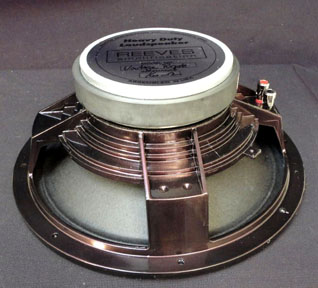
Reeves Vintage Purple speakers with a different cast metal frame from 2013
Reeves Amplification also produce some excellent 2x12 and 4x12 speaker cabinets, fitted with Vintage Purple speakers. They were based on one of the cast metal-framed, purple-backed Fane speakers included with vintage Hiwatt cabs, but the exact model number unknown. The first generation Reeves Vintage Purple speakers were made by Eminence. The cast metal frame used appeared to be the same as the Eminence Delta Pro speakers, which are also the same frame Eminence uses for the Crescendo "A" speakers they make for Hi-Tone. Later, around 2010, Reeves changed to a different speaker with a cast metal frame that looks identical to the old George Scholz Classic/Sugar Cone speakers used in the Harry Joyce speaker cabs. The first generation Purples were very similar to the Hi-Tone Crescendo sound, but not as bright and with slightly less upper mids. They work very well for Gilmour tones. I have never used the second generation Purples speakers, so I do know how they compare, but Reeves says they are not much different than the first gen.
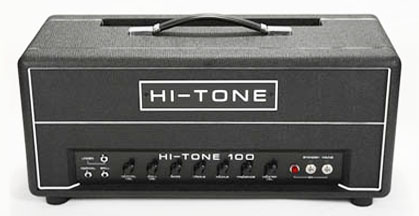
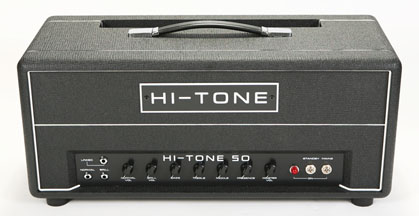
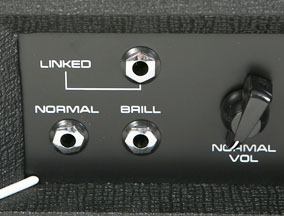
Hi-Tone DG series HT100DG with four EL34 power tubes and HT50DG with two EL34 power tubes, both with linked inputs
HI-TONE Amplification - Hi-Tone /VHR(Vintage Hiwatt Restorations) started off back in 2006 repairing Hiwatts and selling parts and kits to build clones. In the early days they actually recommended people buy from Reeeves if they wanted an assembled Hiwatt, but later started to build complete amps under the Hi-Tone brand. Hi-Tone now sells a full line of DG series amps and combos (HT100DG, HT50DG, HT50 combo) with internally linked inputs and EL34 power tubes. They also make the Lowatt, an18w head and a combo amp version with two 6V6 power tubes. The 100w and 50w heads are reportedly the most accurate Hiwatt amps and cabs on the market, based on the original Hylight era Hiwatts built by Dave Reeves, and built to his specs on turret board, including using 22-gauge, solid-core wire. Partridge output transformers were a key element to the vintage Hiwatt sound, and the Heyboer power transformers Hi-tone uses were reverse engineered from a real Partridge transformer. They are supposedly better than the Partridge transformers used in the originals. They even look like Partridges, with the same style mounting brackets. These power and output transformers have the same model numbers as the Heyboers that Reeves Amplification uses in their Hiwatt replica amps, although Reeves does not use the Partidge-style mounting brackets.
Hi-Tone is run by builder Clayton Calloway, along with Mark Huss, an expert on vintage Hiwatt amps, and Glynn Reeves, the son of late HIWATT founder Dave Reeves. They are also sanctioned by the Reeves family.
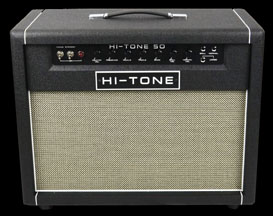
Hi-Tone HT50DG 2x12 combo
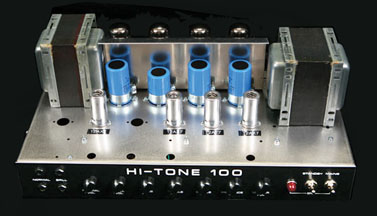
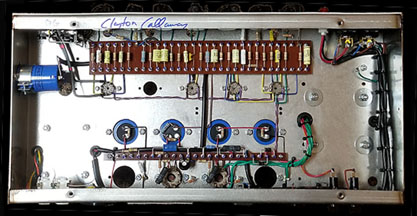
Hi-Tone chassis and circuit
Hi-Tone Crescendo A speakers, made by Eminence, 100DG amp with HT4121 4x12 speaker cabinet, and 100DG with Eclipse 4x12 speaker cabinet
Hi-Tone Eclipse 4x12 speaker cabinet with Crescendo A speakers
Hi-Tone also make impressive 2x12 and 4x12 speaker cabinets, including the Eclipse, which is based on the WEM Starfinder 200 speaker cabinets favored by David Gilmour. While not an exact replica, it is the same size and is built like a tank. The build specs are very similar to the Starfinder and it has a similar embroidered cloth pattern. It is fitted with Hi-Tone Crescendo “A” speakers, made by Eminence in Kentucky, which are very close in tone to the 1970s Fane Crescendo 12 'A' speakers David uses in his WEM cabs. They are made with a replica of a German-made Kurt Mueller cone, the type used in the original 1970s Crescendos. The cone was recreated at the urging of Eminence engineer Anthony Lucas and guitarist Eric Johnson for a signature speaker that never came to fuition, but worked perfectly in the Crescendo "A".
The Crescendo "A" looks identical to the Vintage Purple speakers Eminence made for Reeves Amplification, except the Hi-Tone Crescendo includes a silver dust cap at the base of the speaker cone, like the original Fane Crescendos. They both use the same cast aluminum frame that Eminence uses for thier Delta Pro speakers. The Hi-Tone DR-F speakers are another good option for those who find the Crescendo A speakers to be too bright. DR-F is based on the Fane 125161 purple backed speakers used in vintage Hiwatt cabs from the late 1970s. They are more balanced for a wider variety of music and have less upper mids and more lower mids than the Crescendo A. Hi-Tone also has a Fane 122231 speaker replica called the 231. The 122231 was another purple backed Fane speaker used in vintage Hiwatt cabs. It has a slightly less agressive sound than the DR-F, with less highs and more lower mids.
When I compared the Reeves Vintage Purples to the Hi-Tone Crescendo A speakers, both sound very similar, but the Crescendo A is brighter and has more mid range than the Purples. These speakers can be bought individually on the Hi-Tone site in the replacement speakers section.
Now we get into the drama/soap opera territory of the other options available from the later Hiwatt brand name owners.
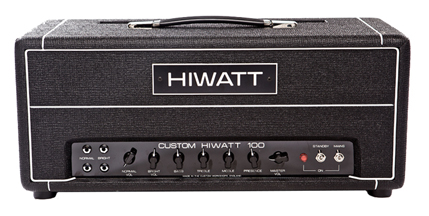
Modern Hiwatt DR-103 head from Hiwatt UK
Hiwatt UK - After Biacrown Electronics went out of business and stopped making Hiwatts in 1984, the name was sold to Rick and Justin Harrison, the father and son team that owned Music Ground in the UK. They purchased both the Biacrown and Hiwatt brand names for the UK/European market, but lost the Hiwatt trademark rights for North America and Japan. Hiwatts were sold under the Reeves brand in North America for a time, then under the Maxwatt brand. There is no relationship of Hiwatt UK/Music Ground to the Dave Reeves family or the original Hiwatt amp makers, and there has been some dispute about the Harrison's actual ownership of the name. Various attempts at making Hiwatts occurred in the 1990s, but it was not until the 2000s that the brand really re-launched with a line of hand wired re-creations of the originals with Partridge transformers. They were originally built by EleKtriK Amplifiers in the early 2000s. Hiwatt UK claimed they were still made in England using the original Hiwatt specs, and point-to-point wiring (originals were actually made on turret board), but there were also new transistor based models made under the Maxwatt brand that may not have been made in the UK. Criticisms from Hiwatt experts were that they did not follow the original Hiwatt specs and were cheaply made, and they did have some quality control issues early on. They were also very expensive. However, I have read some great reviews from people who have actually owned them, including owners of both Music Ground era and original Hylight era Hiwatts who claim they were built and sounded just as good.
One major negative was that the Harrisons who owned the brand in the UK up until 2016 had a long reputation of criminal activity, lying, buying and selling stolen merchandise, selling faked vintage music gear, and counterfeit gear. They even made several "David Gilmour" Signature Series Hiwatts in the 2000s, but David was not involved and did not authorize the use of his name. They even claimed Gilmour used their Hiwatt UK amps for the Pink Floyd reunion in 2005. Phil Taylor, Gilmour's backline tech, said David has only ever used vintage Hylight era Hiwatts from the 1970s, including the PF reunion, and never one made by Hiwatt UK (at the time I wrote this, the Harrisons were being charged with selling stolen merchandise).
In 2016 the Hiwatt brand was purchased by Canadian investors Darren Atkinson and Alex Bak and re-launched in 2017. They claim the Harrisons/Music Ground no longer have any involvement in the company. The Hiwatt UK factory was relocated into one of the old Hiwatt buildings in Doncaster. The same custom shop team are building the amps as during the previous 15 years under the Harrison/Music Ground ownership, so I do not know if anything about the actual amps has changed. I have seen photos of the circuits and visually they look to be made correctly but I have no experience with them. In late 2018 Atkinson and Bak successfully acquired the Hiwatt name rights for North America, Canada, and Japan, allowing the brand to be sold worldwide under the unified Hiwatt name again.
Hiwatt UK DG-103 and DG-504 Signature Series heads from Hiwatt UK/Music Ground period, marketed as if they were authorized/approved by David Gilmour,
but Gilmour had no involvement with them. Hiwatt UK also sold a DG-504 version, and a 20w version called the Little D.
The model names were later changed to SSD-103, SSD-504, and SSD-212. "SS" stood for Signature Series, and "D" for David.
Hiwatt UK/Music Ground made several unlicensed David Gilmour Signature Series amps. The DG-103 and DG-504 heads and DG-212 combo from the 2000s were the same as their DR103/DR-504/SA-212 models, but had linked inputs. I don't know if these were accurately linked the way David's are. Hiwatt UK promoted these "with special modifications as commissioned by Dave Gilmour of Pink Floyd himself", implying Gilmour authorized this and commissioned Hiwatt UK do the mods on his Hiwatts. He did not, and it was actually Pete Cornish who modified Gilmour's vintage Hiwatts. According to a Hwaitt dealer I communicated with, Hiwatt UK were told to stop using David Gilmour's name and remove the DG from the model numbers, so they were changed to SSD-103, SSD-504, and SSD-212. The "SS" standing for Signature Series, but the "D" obviously still stood for David, just as thier SSJ and SSP models stood for Jimmy Page and Pete Townshend. The product description was also altered to say "based on the Custom 100 Head specifically modified for the “Pink Man” himself"". It was later changed to "based on the Custom 100 Head specifically modified for the band Pink Floyd." Hiwatt UK also made an SSD-112 combo with the same description.
Hiwatt UK/Music Ground DG-103 head with unauthorized WEM 4x12 Starfinder speaker cabinet (left), and the same unbranded version (right)
Around 2010 Hiwatt UK sold a China made WEM look-alike 4x12 Starfinder replica cab. It was made of 25mm particle board with a screen printed grille cloth, rather than embroidered like the original WEM cloth. They had no license from Watkins Electronic Music to use the WEM name and logo. The logo briefly appeard on the UK cabs, then was removed from the advertising. It was on the cabs sold in the US for a longer period of time, then production was halted. Around 2014 Hiwatt UK made a "Little D" rig, which was a 20w head with linked inputs and a 1x12 speaker cab made to look like a mini WEM Starfinder cab. Like the 4x12, the speaker and cab were made in China and the grille cloth pattern was screen printed. They again used Gilmour's name in the description - "The Hiwatt Little D rig is based on the amplifier modified by Pete Cornish for David Gilmour of Pink Floyd". I assume they were told to stop using Gilmour's name again, as the description was soon changed to "based on the SSD Signature Series amplifier configuration that was used by Pink Floyd" and Little D was changed to Little D LRD MkII". "LR" stood for Little Rig, and "D" obviously for David. The WEM badge appeared on the version sold in the US, but was not on the UK version. Later teh WEM graphics/colors were changed to Hiwatt graphics/colors.
(left) Hiwatt UK/Music Ground "Little D" 20w head and unauthorized "scaled down" WEM 1x12 Starfinder speaker cabinet, from 2014.
(right) Hiwatt UK LRD Mk II "Little D" 20w head and Hiwatt 1x12 speaker cabinet, from 2015.
Fernandes Hiwatt - The North American, Canada, Japan Hiwatt trademark name owner. Fernandes acquired the Hiwatt trademark when a partner of the UK brand owners (The Harrisons/Music Ground) set up a US distributorship, then got into financial trouble with Fernandes. They claimed the name as part of the debt owed, then trademarked it. Fernandes made several amp lines under the Hiwatt brand, including a few of the traditional Hiwatt amps like the DR103 and SA212. Hiwatt UK had a long battle with them over name ownership, and in the end a deal was settled and Fernandes stopped manufacturing Hiwatts and basically became a distributor for Hiwatt UK, although it appears they did not support the brand very well. They sold amps imported from the UK, made in the same factory making Hiwatt UK/Music ground Hiwatts. See info above about Hiwatt UK. Hiwatt UK then created the Maxwatt brand to sell in the US, Canda, and Japan directly. In late 2018 the new Hiwatt UK owners succesfully acquired the Hiwatt name from Fernandes, allowing them to use it worldwide.
Maxwatt - These were re-branded Music Ground/Hiwatt UK products, including the UK made and and China made amps. Hiwatt UK created this brand in order to sell in territories like the US, Canada, and Japan where Fernandes owns the Hiwatt trademark. When when the Hiwatt name changed hands in 2016, the new Canadian owners continued to used the Maxwatt name for these territories, but in late 2018 they succesfully acquired the Hiwatt name for all worlwide territories.
Kit’s Secret Guitar, Gear, and Music Page
Guitar stuff, gear stuff, soundclips, videos, Gilmour/Pink Floyd stuff, photos and other goodies.
Copyright Kit Rae.
VISIT MY SWORDS, KNIVES and FANTASY ART WEBSITE www.kitrae.net


